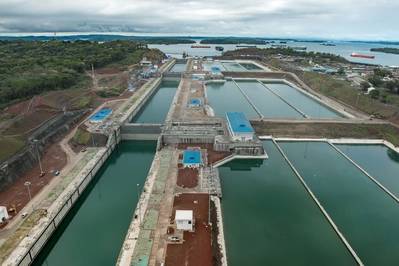The newly inaugurated Panama Canal may not be as beneficial as it seems for container ship carriers, says Xeneta, a benchmarking and market intelligence platform for containerized ocean freight.
Although the new sets of locks and deeper, wider shipping channels will potentially double the waterway’s capacity, giving neo-panamax vessels access for the first time, the increased efficiencies may actually undermine rates – deepening the crisis for a segment already suffering the strains of severe over capacity and cut-throat competition.
Xeneta - which boasts a database of more than 12 million contracted ocean freight rates, crowd sourced from more than 600 major international businesses – has charted a spectacular fall in container rates over the last two years. As an example, the short-term market average rate for transporting a 40-foot container from Shanghai to Rotterdam has fallen by over 60 percent since Summer 2014 (currently standing at $941).
The Panama Canal extension, opened on June 26 by the 9,472 TEU Cosco Shipping Panama, was meant to be a boon for carriers, giving vessels carrying around 13,000 TEU's all-water access from Asia to the crucial U.S. East Coast ports and inland markets. But, according to Xeneta CEO Patrik Berglund, this neo-panamax shortcut could come at a crippling cost.
“On the face of it improved transit times and two way traffic deliver huge benefits for container carriers,” Berglund said, “facilitating more cargo to the U.S. East Coast and Caribbean ports faster and cheaper. However, there could be real trouble brewing on the horizon.”
“Firstly, the neo-panamax vessels have to attract trade to this fresh route, and this could initially force them to keep rates artificially low - the last thing the industry needs. Then we have the fact that more ships will be able to compete on the East Coast, potentially pushing rates even lower,” Berglund said.
“This will most probably be exacerbated by the newly arriving fleets of 18-20,000 TEU megaships – MSC has four in the pipeline now – causing a cascading of existing tonnage onto attractive routes, like the East Coast. It all spells, what could be, an impending financial disaster for a segment currently defined by consolidation, new alliance-building, and on-going uncertainty.”
Berglund is backed up in his analysis by Rosemont College Professor Andrew Lubin, a specialist in container freight and logistics. He notes that, at present, 68 percent of container movement from Asia into the U.S. East Coast comes via the West Coast, but believes that about 10-14 percent of that will be diverted to the Gulf and East Coast ports within the year.
“Faster transit times and the fact that carriers switching tonnage to the East Coast will now be able to avoid West Coast labor unions will boost vessel numbers and therefore competition,” he said. “Increased competition has an obvious impact in the market - lower rates.”
Berglund concludes that this is only the latest development for an industry that is currently in a constant state of flux.
“Rates across the more than 60,000 port-to-port pairings we cover are changing all the time,” Berglund stated. “For shippers, freight forwarders and carriers to keep pace with developments, and get the right price for their cargoes, they have to use software such as ours to exploit the true potential of big data.
“Information is knowledge and, especially in a market like today’s, has to be the cornerstone of every key business decision.”













